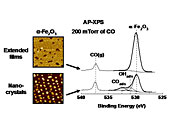- Number 331 |
- February 21, 2011
Synchrotron X-rays shine a light on the reactivity of water-gas shift catalysts

The interaction of CO with
nanocrystals and continuous
films of α-Fe2O3 grown on
Au(111) was investigated
using in situ X-ray
photoelectron spectroscopy
(XPS) at near ambient
pressure (200 mTorr) and
scanning tunneling microscopy.
In order to better understand how water-gas shift (WGS) catalysts convert carbon monoxide and water from gasified coal into electrical power and valuable fuels, researchers at DOE’s National Energy Technology Laboratory have turned to synchrotron-based x-ray techniques. Synchrotron x-rays can be a billion times brighter than those generated by the sun, offering extraordinary opportunities for using this region of the electromagnetic spectrum to better understand fossil energy based technologies that impact our daily lives. Such x-rays are bright enough to produce results on catalyst systems in a matter of hours whereas lower intensity laboratory based techniques would take almost a decade to produce the same data. To conduct this work, NETL researchers have been using a specialized instrumental technique developed by collaborators at Lawrence Berkeley National Laboratory’s Advanced Light Sources (ALS). The ALS is a $99.5 million synchrotron user facility that provides extremely intense soft x-ray light for electronic structure measurements, crystallography, and x-ray microscopy measurements. The researchers used a technique called ambient pressure x-ray photoelectron spectroscopy to determine the mechanism of the catalytic reaction, the molecular intermediates involved, and the electronic structure changes required to activate these catalysts for WGS reactions. The NETL-ALS team found that defects which reside at the edges of a catalyst’s crystalline lattice and, to some extent, the interactions of these defects with the support they are grown on, seem to be critical features governing their WGS activity. The information gathered from these synchrotron studies can be used to guide the production of cheaper and more efficient WGS catalysts. The team recently reported on their use of synchrotron x-rays for studying an iron-based WGS catalyst in the Journal of Physical Chemistry C (Vol. 114, 2010, p. 22619-22623).
